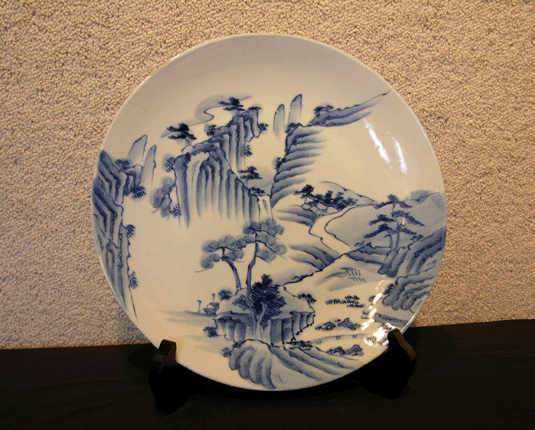
Edo Period, ca 1850, 12.5″d. Kiln seal at bottom. Important for being presented to an esteemed American missionary doctor in Korea after the Japanese Occupation. Certified.
This plate was originally produced in Japan but taken to Korea during the Japanese Occupation. It was presented after the war to Dr. Moffet, an esteemed American missionary doctor in Korea for his missionary work done in that country. For his charitable work, Dr. Moffet was given honorary Korean citizenship by the Korean government.
Japanese Imari was very rare in Korea at that time. Dr. Moffet eventually gave this plate to his adopted Korean son, Chung Dal Ho, a Professor of Korean History and Antiquity, and an avid collector of Asian antiques. Mr. Chung was one of only thirteen antiques appraisers recognized by the Korean government. He discovered this charger in one of his Korean antique chests, after having forgotten about it and left it in the chest for many years. He certified this plate.
During the Edo period, Blue-and-White wares were made for domestic use, not for export, and were called “sometsuke mono” in Japan. The Japanese valued them because of their simplicity and utilitarian look, which were more suitable to Japanese surroundings. The ruggedness of pottery, rather than fine porcelain, appealed more to their practical nature and taste. They could appreciate this brand of beauty and charm and disliked the fine porcelain with multi-colors made for Europe which appealed to Western taste but found no demand in Japan.
This plate has the classical look of early blue-and-white wares, which show a generous amount of white space and not crowded with designs. It shows a landscape of towering mountains and pine trees, with a couple of sailboat peeping out around the bend of low hills and rock formations. It is a scene borrowed from classical Chinese landscape paintings, the kind the Japanese admired so much and typically copied as a model in early Japanese art. It was not until quite late that Japanese designs evolved.
The blue on this plate is produced by some form of cobalt or indigo pigment painted directly into the biscuit (paste), after which the plate is glazed. The unclustered look and the dark and soft blue hues of the pattern give this charger a quiet beauty so appreciated by the Japanese of olden days. The bottom of the plate is decorated with floral sprigs in dark cobalt blue, connected by a slim line in blue, on a white ground. Three more thin blue lines complete the design. This plate shows some wears at the rim, showing that it was much used and appreciated for what it was meant to be, for household use. It adds character to the plate. An under-the-glaze blue seal mark of the kiln producing this plate is at the bottom of the plate.